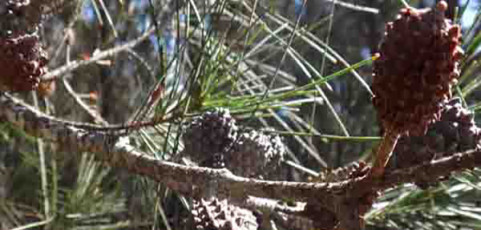By the early 1950s it gradually became clear that Bridport’s water supply system needed upgrading as the town continued to grow. The pump was often broken down and many attempts were made to repair it. Water supplies were inconsistent and not able to deal with growing demand. A new motor was installed in 1952 with only limited success. By the 1960’s a new pump house was installed near the Elizabeth street entrance. This is still...
Spiky Tree Fern
The hardy and adaptable Cyathea australis or Spiky tree fern is found at Tree Fern Gully on the River-Forest section of the circuit. It has roots and hair like follicles on its trunk giving it a rough texture and it is adaptable to a variety of climates and soils. Ferns are also amongst the oldest plants in the world dating back to the Carboniferous period 360 million years ago and the Spiky Tree fern is wholly protected in...
Sheoak closeup
The She-oak ( Allocasuarina littoralis ) ‘closed’ forests are remarkably quiet. It is the most drought resistant tree in Tasmania. The needle like foliage is a dull dark grey. The fallen needles create a soft cushioning mat.
The Native Cherry
The Native Cherry (Exocarpus cupressiformis) tree is a semi-parasitic plant. It attaches to the roots of the dominant black peppermint eucalypt trees around it. It is an attractive conical shaped tree with bright green dense foliage.
White gum
White gum ( Eucalyptus viminalis), are dominant on the river reserve near the Ada Street shelter. Alongside the river there are moisture-loving herbs, ferns, sedges, rushes and reeds. Paperbark swamplands occur where the Brid River flows into Anderson Bay. A riparian corridor with dense plantings of a range of small native trees and shrubs is important to the restoration of the Riparian reserve. Riparian revegetation practices helps stabilise...
Black Peppermint
The Black Peppermint ( Eucalyptus amygdalina) is endemic to Tasmania and a dominant tree on the River-Forest track. It is known for its rough bark and narrow peppermint scented leaves when crushed.
Burrowing Crayfish
The swampy low lying areas of the River-Forest track provide the perfect habitat for the tiny and vulnerable Burrowing Crayfish ( Engaeus genera).
Swamp-Rat
The nocturnal Swamp (velvet-furred) Rat ( Rattus Lutreolus) is a native small mammal, half the size of the introduced black and brown rats. It forms extensive systems of runways beneath dense vegetation.
Welcome to Country
“Yah Pulingina” -Welcome to Country. In respect and recognition of the leenerrerter the traditional owners of the coast and hinterlands around Bridport.
Ceremonial Ochre
Ochre was an important cultural resource for the leenerrerter . Aboriginal women obtained and prepared ochre. It was ground into a sacred powder and used for ceremonial body and tree marking. It was also mixed with grease to waterproof the body, hair and beards of the men. Present day Tasmanian Aborigines still consider ochre to be a special cultural resource. Polelerwine (red ochre) is highly prized. ...











